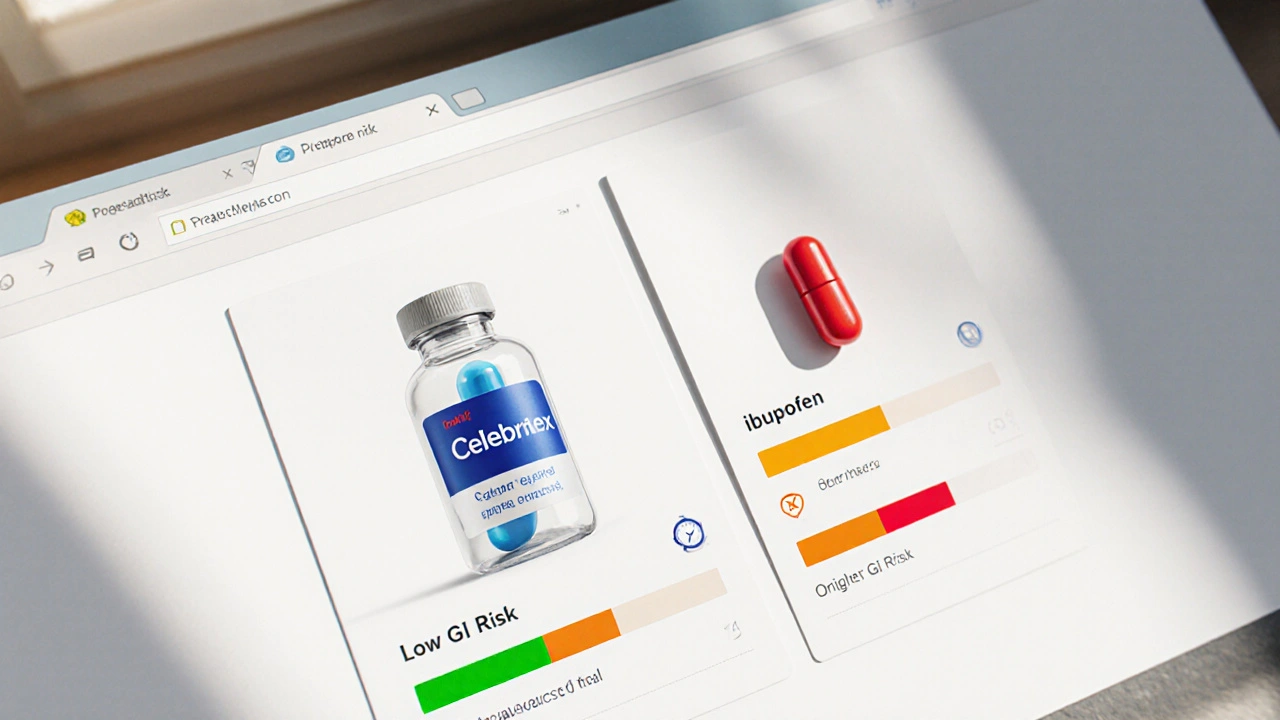Celebrex vs Other Pain Relievers Comparison Tool
Select two pain relievers to compare their key characteristics and determine which might be better suited for your needs.
Comparison Results
Key Differences Summary
Key Takeaways
- Celecoxib (Celebrex) is a selective COX-2 inhibitor that lowers stomach‑related side effects but may raise cardiovascular risk.
- Non‑selective NSAIDs like ibuprofen and naproxen are cheaper and widely available, yet they carry higher GI bleeding risk.
- Acetaminophen is safe for the stomach but ineffective against inflammation.
- Meloxicam offers a middle ground: partial COX-2 selectivity with twice‑daily dosing.
- Choosing the right drug depends on your condition, existing health issues, and how quickly you need relief.
When you search for Celebrex alternatives, you’re probably weighing pain relief against safety, cost, and convenience. Below you’ll find a step‑by‑step breakdown that lets you compare Celebrex (celecoxib) with the most common substitutes, see where each shines, and decide which fits your lifestyle.
How Celecoxib Works
Celecoxib is a selective COX‑2 inhibitor that blocks the enzyme cyclo‑oxygenase‑2, reducing prostaglandin production responsible for pain and inflammation. Because it spares COX‑1, the enzyme that protects the stomach lining, celecoxib generally causes fewer gastrointestinal (GI) ulcers than traditional NSAIDs.
The drug is prescribed for osteoarthritis, rheumatoid arthritis, ankylosing spondylitis, and acute pain after surgery. Typical oral dosing ranges from 100mg once daily to 200mg twice daily, depending on the indication.
Major Alternatives Overview
Below is a quick snapshot of the top contenders you’ll encounter when searching for pain‑relief options:
- Ibuprofen - a non‑selective NSAID, fast‑acting, widely used for mild‑to‑moderate pain.
- Naproxen - another non‑selective NSAID, longer half‑life, often preferred for chronic conditions.
- Diclofenac - potent NSAID, available in oral and topical forms, higher GI risk.
- Aspirin - classic NSAID, also antiplatelet, used in low doses for heart protection.
- Acetaminophen - analgesic/antipyretic, no anti‑inflammatory effect, minimal GI impact.
- Meloxicam - a partially selective COX‑2 inhibitor, taken once or twice daily.

Comparison Table
| Brand / Generic | Drug Class | Typical Dose | Onset of Relief | GI Risk | Cardiovascular Risk | OTC Availability |
|---|---|---|---|---|---|---|
| Celebrex (celecoxib) | Selective COX‑2 inhibitor | 100mg once‑daily or 200mg twice‑daily | 30-60min | Low | Moderate‑high (especially in patients with heart disease) | Prescription only (Australia) |
| Ibuprofen | Non‑selective NSAID | 200-400mg every 4-6h (max 1200mg OTC) | 15-30min | Moderate‑high | Low‑moderate | OTC |
| Naproxen | Non‑selective NSAID | 250-500mg twice daily | 30-60min | Moderate‑high | Low | OTC (low dose) |
| Diclofenac | Non‑selective NSAID | 50mg three times daily | 30-45min | High | Moderate | Prescription (some OTC gels) |
| Aspirin | Non‑selective NSAID (antiplatelet) | 81-325mg daily (low‑dose) or 500mg every 4-6h (pain) | 30-45min | Moderate‑high | Low (protective at low dose) | OTC |
| Acetaminophen | Analgesic/antipyretic | 500mg every 4-6h (max 3000mg) | 30-60min | Very low | Very low | OTC |
| Meloxicam | Partial COX‑2 selective NSAID | 7.5mg once daily (or 15mg twice daily) | 45-60min | Low‑moderate | Moderate | Prescription |
Choosing the Right Option
Here’s a quick decision flow you can use:
- Do you need anti‑inflammatory action? If yes, skip acetaminophen and pick a NSAID or COX‑2 inhibitor.
- Is stomach protection a priority? Choose celecoxib or meloxicam for lower GI risk, or take any NSAID with a proton‑pump inhibitor.
- Do you have cardiovascular disease or risk factors? Prefer ibuprofen (at the lowest effective dose) or naproxen, as they have a comparatively lower CV profile than celecoxib.
- Budget constraints? Over‑the‑counter options like ibuprofen, naproxen, and acetaminophen are cheaper than prescription celecoxib.
- How fast do you need relief? Ibuprofen and aspirin act within 15-30minutes, while celecoxib may take a bit longer (up to an hour).
For chronic arthritis, many rheumatologists start patients on celecoxib for its GI safety, then consider switching to naproxen if cardiovascular concerns arise. For occasional back pain, ibuprofen or naproxen often suffice.
Safety & Side‑Effect Highlights
All these drugs share some overlap but also distinct risk profiles:
- GI bleeding: Highest with diclofenac and non‑selective NSAIDs; lowest with celecoxib and acetaminophen.
- Kidney function: NSAIDs can reduce renal blood flow; monitor creatinine if you have pre‑existing kidney disease.
- Heart risk: Celecoxib shows a modest increase in heart attack risk, especially at doses >200mg/day. Naproxen is considered the safest NSAID for patients with heart disease.
- Liver toxicity: Rare with most NSAIDs but acetaminophen can cause severe liver injury if exceeding 4g/day.
- Allergic reactions: Aspirin‑intolerant patients should avoid all NSAIDs, including celecoxib, due to cross‑reactivity.
Always discuss your full medical history with a pharmacist or doctor before swapping drugs.
Frequently Asked Questions
Can I take Celebrex with ibuprofen?
Mixing two NSAIDs isn’t recommended because it raises GI and kidney risk without adding pain relief. If ibuprofen isn’t enough, talk to your doctor about switching, not stacking.
Is Celebrex covered by Australian Medicare?
Celebrex is prescription‑only and generally not listed on the Pharmaceutical Benefits Scheme (PBS) for most indications, so you’ll likely pay out‑of‑pocket unless you have private insurance that includes it.
What makes meloxicam a “partial” COX‑2 inhibitor?
Meloxicam inhibits COX‑2 about 3‑times more than COX‑1, but not as exclusively as celecoxib. This gives it a balanced safety profile-lower GI risk than ibuprofen but a bit higher than celecoxib.
Can older adults safely use over‑the‑counter NSAIDs?
Age‑related changes in kidney function and stomach lining make seniors more vulnerable to side effects. A low dose, short‑term course, and accompanying food can help, but a doctor’s review is best.
Is there a non‑drug way to reduce the need for Celebrex?
Physical therapy, weight management, and targeted heat or cold packs can lower joint stress. Many patients combine lifestyle tweaks with occasional medication to keep overall drug exposure low.
Armed with this side‑by‑side view, you can pick a pain‑relief strategy that respects your stomach, heart, and wallet. Remember, the best choice is the one that fits your unique health picture, not the one that sounds cheapest or most popular.







Shweta Dandekar
October 5, 2025 AT 01:31It is absolutely unforgivable, dear readers, to neglect the moral responsibility we hold when choosing pain medication!!! We must consider the sanctity of our bodies, the dignity of our choices, and the ethical implications of self‑medicating without proper guidance!!! The reckless consumption of NSAIDs without acknowledging their gastrointestinal and cardiovascular risks is a betrayal of personal integrity!!! Let us all pledge to consult professionals, read labels diligently, and respect the delicate balance of our health!!!
Gary Smith
October 5, 2025 AT 23:33America has always led the world in medical innovation, and our pain‑relief options are no exception!!! The brilliance of celecoxib and its alternatives reflects the ingenuity of our pharmaceutical industry, unmatched by any other nation!!! When you compare these drugs, remember that the United States sets the highest standards for safety and efficacy!!! Proudly choose the options that come from our great nation!!!
Dominic Dale
October 7, 2025 AT 03:20There is a hidden agenda behind the promotion of Celebrex that the mainstream medical community refuses to disclose. The pharmaceutical giants have colluded with regulatory bodies to keep the public in the dark about long‑term cardiovascular dangers. This partnership is funded by shadowy donors whose identities remain classified. Every clinical trial you read is filtered through a veil of data manipulation. The comparative tables you see are generated by algorithms designed to mislead. Independent researchers have been silenced, their papers buried under paywalls that only the elite can afford. The risk assessments labeled as “moderate‑high” are deliberately vague to prevent panic. Moreover, the OTC availability of ibuprofen is a calculated move to channel profit away from safer alternatives. The internet forums buzzing about these drugs are, in fact, bots programmed to steer opinions. Your doctor’s recommendation may be influenced by kickbacks from drug manufacturers, a fact rarely reported in mainstream media. The marketing scripts embed subtle cues that condition you to accept higher cardiovascular risk as normal. Even the non‑selective NSAIDs carry a hidden nephrotoxic component that is rarely discussed. Some patients report mysterious kidney failures after weeks of “safe” ibuprofen use, yet these cases are dismissed as anecdotal. The entire regulatory framework is built on a foundation of corporate interests, not patient welfare. Ultimately, the truth about celecoxib and its alternatives remains obscured, and only diligent, critical minds can pierce the veil.
christopher werner
October 8, 2025 AT 07:06Thank you for the thorough breakdown; the comparison chart is clear and helpful. I appreciate the balanced presentation of GI and cardiovascular risks, which makes it easier to discuss options with my physician. Your effort in simplifying the data is commendable.
Matthew Holmes
October 9, 2025 AT 10:53The shadows whisper that celecoxib is a wolf in sheep’s clothing, a silent pact between power and profit, and the truth is veiled in silence
Patrick Price
October 10, 2025 AT 14:40Yo i saw ur post i think u should realy try celebrex but also watch out for peple say it maked my stomach hurt a lot i had to stop and i dont know why maybe its u dont follow the dose properly lol
Travis Evans
October 11, 2025 AT 18:26Hey folks! If you’re juggling joint pain and worry about tummy upset, think of celecoxib as your “gentle giant” – strong on inflammation but kinder to the gut. Pair it with a solid diet, stay hydrated, and you’ll feel the relief without the burn. Keep crushing those goals!
Jessica Hakizimana
October 12, 2025 AT 22:13Life’s journey often feels like a winding road, and pain can be an unexpected pothole, yet with the right tools-like a thoughtful choice between celecoxib and its peers-we can smooth the ride. Embrace the knowledge presented, weigh each risk like a philosopher weighing ideas, and move forward with confidence. The universe rewards those who act wisely.
peter derks
October 14, 2025 AT 02:00Great overview! This really helps me decide which medication fits my lifestyle.
Sarah DeMaranville
October 15, 2025 AT 05:46While many hail celecoxib as superior, one must consider that the data is far from conclusive.
Edward Leger
October 16, 2025 AT 09:33The comparison invites contemplation on the trade‑offs between efficacy and safety, urging us to reflect on how we value short‑term relief against long‑term health.
Keyla Garcia
October 17, 2025 AT 13:20Wow, this chart is a roller‑coaster of emotions! 🎢 The stakes feel life‑or‑death when you read about heart risks 😱, yet the hope shines through with low GI options 🌟. Can’t believe I’ve been missing this info all along! 🙌
Ismaeel Ishaaq
October 18, 2025 AT 17:06Fantastic work! I’m thrilled to see such detailed analysis-let’s keep digging deeper, ask bold questions, and push for even safer pain solutions together! 🚀
Jesse Goodman
October 19, 2025 AT 20:53Excellent summary!
Antara Kumar
October 21, 2025 AT 00:40India’s own traditional remedies often outperform these imported drugs, and blindly trusting foreign pharmaceuticals is a mistake.